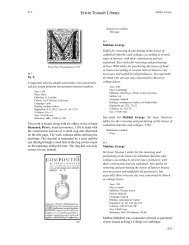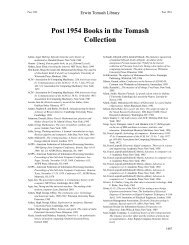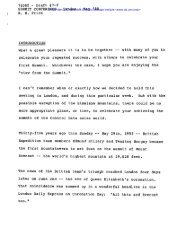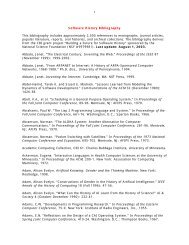B chapter.indd - Charles Babbage Institute - University of Minnesota
B chapter.indd - Charles Babbage Institute - University of Minnesota
B chapter.indd - Charles Babbage Institute - University of Minnesota
Create successful ePaper yourself
Turn your PDF publications into a flip-book with our unique Google optimized e-Paper software.
Erwin Tomash Library<br />
Booth, Andrew Donald Booth, Andrew Donald<br />
<strong>of</strong> programming, the use <strong>of</strong> subroutines and some<br />
examples such as X-ray crystal structure analysis—a<br />
subject in which the Booths had previous experience.<br />
This book, which has the feel <strong>of</strong> being written by someone<br />
who actually knows the material very well and can<br />
explain it in a way that is easily understood, was a success<br />
in Britain but, while known and appreciated by some in<br />
America, did not receive the same acknowledgement<br />
here.<br />
Illustrations available:<br />
Title page<br />
A.P.E.(R)C. machine<br />
Disk/pin mechanical memory<br />
A.P.E.(R)C. machine, B 204<br />
Disk/pin mechanical memory, B 204<br />
B 205<br />
Booth, Andrew Donald (1918–) and Kathleen H. V.<br />
Booth<br />
Automatic digital calculators<br />
Year: 1956<br />
Place: London<br />
Publisher: Butterworths Scientific Publications<br />
Edition: 2nd<br />
Language: English<br />
Figures: 4 photographic plates<br />
Binding: original cloth boards; with dust jacket<br />
Pagination: pp. xii, 262<br />
Size: 216x138 mm<br />
This second edition has been extended by the new<br />
discoveries <strong>of</strong> the Booths and others. Although the same<br />
material is covered as in the first edition, there is, for<br />
example, a more detailed treatment <strong>of</strong> magnetic core<br />
memory.<br />
A third edition (also in the collection) was published<br />
in 1965 after the Booths had moved from Britain to<br />
Canada. While they provided a major revision for this<br />
later edition, it soon became clear that this book was not<br />
appropriate for the middle <strong>of</strong> the 1960s. Some <strong>of</strong> the<br />
material, for example, the mechanical memory and relay–<br />
based circuits, was simply out-<strong>of</strong>-date, and readers were<br />
in search <strong>of</strong> programming descriptions more applicable<br />
to individual machines. The frontispiece was changed to<br />
show a new M3 computer that the Booths had developed<br />
at the <strong>University</strong> <strong>of</strong> Saskatchewan.<br />
Illustrations available:<br />
Title page<br />
B206.<br />
Booth, Andrew Donald (1918–) and Kathleen H.V.<br />
Britten<br />
Principles and progress in the construction <strong>of</strong> highspeed<br />
digital computers. In Quarterly Journal <strong>of</strong><br />
Mechanics and Applied Mathematics, Vol. II, Pt 2, June<br />
1949.<br />
Year: 1949<br />
Place: Oxford<br />
Publisher: Clarendon Press<br />
Edition: 1st<br />
Language: English<br />
Binding: original paper wrappers<br />
Pagination: pp. 182–197<br />
Collation: K–R 8<br />
Size: 233x155 mm<br />
At this time Kathleen Britten was an assistant to A. D.<br />
Booth at Birkbeck College and was shortly to become<br />
Mrs. Booth.<br />
This is a very early discussion <strong>of</strong> the principles <strong>of</strong> the<br />
stored program computer as they were understood in<br />
1947, when the paper was first written. After a brief<br />
discussion <strong>of</strong> digital versus analog computers, the basic<br />
structure <strong>of</strong> the stored program computer is explained.<br />
The paper finishes with a discussion <strong>of</strong> the state <strong>of</strong><br />
computer projects in the United States (A. D. Booth<br />
having just returned from a trip there), including those<br />
<strong>of</strong> Aiken’s Mark II, the Bell Model V, the EDVAC and<br />
von Neumann’s IAS machine. Several noteworthy items<br />
appear in this paper, including the distinction between<br />
175







